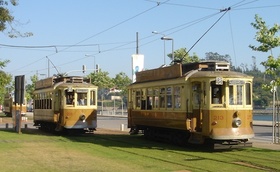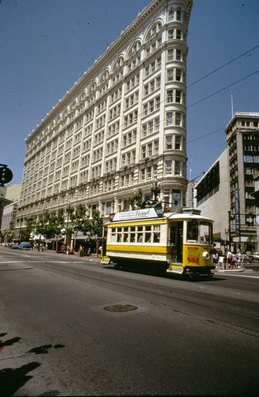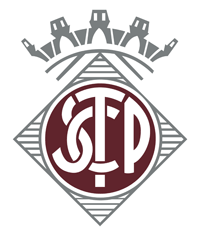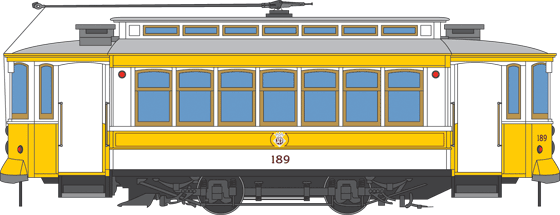A century ago, America was the world technology leader – in streetcars! U.S. firms such as the J.G. Brill Company of Philadelphia exported their products to numerous countries around the globe.
This streetcar (or tram, as they’re called in Europe) is a knock-off of a Brill product, built in 1929 by crafts workers in Porto, Portugal. In Portuguese, the city’s name is “O Porto,” which simply means “the port.” Not surprisingly, maritime commerce has driven this city’s economy for centuries – that, and the wonderful wine named for the city.
 Porto bought Brill streetcars in kit form in the early 1900s. When they needed more cars, they chose to simply copy the Philadelphia product. This is one of those copies. Both Porto and the capital, Lisbon, ran Brill streetcars – and locally produced copies – throughout the Twentieth Century. Lisbon has lovingly restored and updated a few of its lines, especially those that twist and climb through the old Alfama district–one of the great streetcar rides in the world today! Porto, too, has retained two great vintage lines that still use these cars, pictured above where the two lines meet on the riverfront.
Porto bought Brill streetcars in kit form in the early 1900s. When they needed more cars, they chose to simply copy the Philadelphia product. This is one of those copies. Both Porto and the capital, Lisbon, ran Brill streetcars – and locally produced copies – throughout the Twentieth Century. Lisbon has lovingly restored and updated a few of its lines, especially those that twist and climb through the old Alfama district–one of the great streetcar rides in the world today! Porto, too, has retained two great vintage lines that still use these cars, pictured above where the two lines meet on the riverfront.
Some of Porto’s old Brills–both tiny single-truck cars and somewhat larger (but still small) double-truckers–got scattered across the globe when the city cut lines in the 1980s. They were perfect for heritage trolley operations, since they were similar to streetcars that had run in many American cities (though, interestingly enough, never in San Francisco). Memphis, for example, now relies on several ex-Porto cars for its vintage streetcar line.
When the first San Francisco Historic Trolley Festival was planned in 1983, the Chamber of Commerce leased two ex-Porto single-truck cars from Paul Class, an Oregon streetcar entrepreneur. Their bouncy ride, beautiful interior woodwork and rattan seats made them very popular. But the cars were very tired mechanically, and their wood bodies were held together more by habit than anything else. Since the Festival was originally conceived as a one-time event, they were not intended to have a permanent home here. Indeed, one of the cars, No. 122 (a 1912 Brill kit), went to Dallas, where it operates today as part of the delightful McKinney Avenue heritage trolley line.
 This car, No. 189, was brought back to San Francisco in 1984, bought by Muni, and operated in the remainder of the Trolley Festivals. In 1987, it joined the only other single-truck car in the fleet, No. 578-S, in a successful demonstration of the potential popularity of a waterfront streetcar line. The two antiques towed modern generators (to provide power in the absence of overhead wires) along the abandoned State Belt freight railroad tracks from the Ferry Building to Pier 39. The popularity of the trial run clinched the extension of the F-line along the waterfront.
This car, No. 189, was brought back to San Francisco in 1984, bought by Muni, and operated in the remainder of the Trolley Festivals. In 1987, it joined the only other single-truck car in the fleet, No. 578-S, in a successful demonstration of the potential popularity of a waterfront streetcar line. The two antiques towed modern generators (to provide power in the absence of overhead wires) along the abandoned State Belt freight railroad tracks from the Ferry Building to Pier 39. The popularity of the trial run clinched the extension of the F-line along the waterfront.
Unfortunately, this car was completely neglected after the Trolley Festivals ended, and deteriorated badly. Market Street Railway volunteers performed some cosmetic maintenance to arrest the decline of the car, but it has not operated since 1987.
In 2002, Muni’s world-class carpentry shop, which has focused primarily on cable cars, began a long-term project of rebuilding No. 189. They built a new chassis around the single truck, which was overhauled along with the motors and controllers by Muni’s maintenance team. But other projects then put this restoration on hold. Body work is required, including the lengthening of the platforms to accommodate disabled riders, along with installation of a new electrical system and plumbing (for air brakes). If funding can be found, the goal is to return No. 189 to the F-line fleet to provide more decades of delight to rider is *this* great port city.
 Originally Built For
Originally Built ForPorto, Portugal, 1929
Acquired by Muni From
Paul Class, Oregon, 1984
Builder
Comp. Carris de Ferro do Porto Shops
Seats
23
Weight
28,000 lbs.
Length
30′ 6″
Width
7′ 10″
Height
11′ 3″
Control
GE B54E
Trucks
Brill 21E (single)
Motors
2-GE 270 (55 hp each)
Brakes
Air, electric, hand
